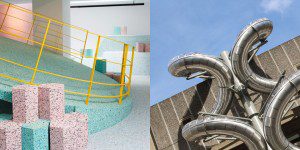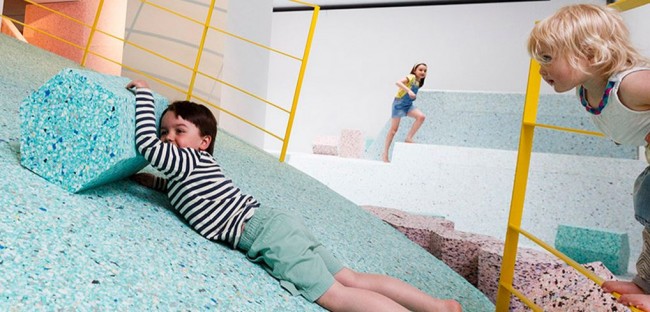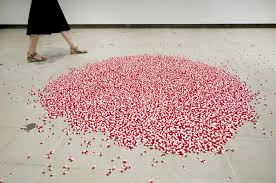Playing Rough
 Review by Matt Bloomfield | 01 August 2015
Review by Matt Bloomfield | 01 August 2015
This summer in London has seen the opening of two exhibitions, both set against a backdrop of brutalism and with a pronounced vein of playfulness. The RIBA Gallery is currently occupied by The Brutalist Playground, an interactive installation created by architecture and design collective du jour- Assemble, in collaboration with artist Simon Terrill. Meanwhile, the Hayward Gallery on the Southbank has staged Decision, its latest blockbuster exhibition, with Belgian entomologist turned artist, Carsten Höller.
Höller is an artist whose work often manifests in the architectural, with his signature helter-skelter slides previously occupying the Tate Modern turbine hall and the Vitra Campus in Weil am Rhein. This exhibition continues his building scale interventions with tunnels, flying machines, and two more slides. Conversely, Assemble who are typically labelled as part of the architectural community, now find themselves on the Turner Prize shortlist for a community regeneration scheme in Liverpool, and praised for their sculptural intervention at the RIBA.
The Brutalist Playground recreates children’s play equipment originally constructed at the Balfron Tower and in the Churchill Gardens estate. In reality these post-war designs for play were formed from the same concrete as the surrounding schemes of comprehensive redevelopment, creating fascinating forms and letting the architects stretch their imagination, but ultimately proving not overly suitable for a group of children to climb around on. The brochure states that Assemble’s installation explores ideas of risk within design, but for several reasons including practicality and no doubt indemnity, the play equipment is entirely clad in foam rubber. The spongy shell, white with flecks of colour indicating differing densities, gives the impression of monolithic pieces of nougat. Certainly it seemed to act as a sound dampener for the screams of the children occupying it.
 After the hype surrounding this exhibition and the praise it has received in reviews, it was disappointing to experience the scale of the installation. Chiefly made up of three components, the flying saucer and giant’s causeway from Churchill Gardens, and the Balfron’s concrete slide, it felt limited in scope and vision, physically if not ideologically. Other visitors clearly didn’t share my reservations though. As children threw the hexagonal foam columns down the slide and clambered across the flying saucer with its steel handrail still providing plenty of risk, their weary parents promised that they could come back another day if they would go home now.
After the hype surrounding this exhibition and the praise it has received in reviews, it was disappointing to experience the scale of the installation. Chiefly made up of three components, the flying saucer and giant’s causeway from Churchill Gardens, and the Balfron’s concrete slide, it felt limited in scope and vision, physically if not ideologically. Other visitors clearly didn’t share my reservations though. As children threw the hexagonal foam columns down the slide and clambered across the flying saucer with its steel handrail still providing plenty of risk, their weary parents promised that they could come back another day if they would go home now.
The Brutalist Playground provokes several questions, which seems to have been Assemble’s intention, not just about risk within play but also environmental determinism and the use of architecture to influence particular behaviours. Furthermore it challenges assumptions about who architecture is for and, as part of a wider nostalgia for the post-war welfare state, brings attention to brutalist architecture not as a choice of material or particular form but a concerted effort to improve living conditions.
Carsten Höller’s Decision is more upfront in its presentation of questions. Just to enter the gallery you are given the choice of two doors, each of which leads into a corridor of steel ducting, devoid of light which you have to navigate by touch. But with both of these corridors exiting at the same point, and a gallery assistant then directing you to walk a certain way around the next artwork, this choice is immediately undermined.
 Höller’s piece Pill Clock, which drops a tablet from the ceiling every 5 seconds throughout the duration of the exhibition, 1.2 million tablets in total, presents visitors with a second choice. Gallery assistants are again on hand to tell you that you may take one of the pills, a water fountain is provided. Of course, whether you take the tablet or not has no impact on your experience of the exhibition, nor are you given the choice to take more than one pill; kicking over the whole pile of pills and scattering them across the room, as one toddler did in front of me, is clearly frowned upon.
Höller’s piece Pill Clock, which drops a tablet from the ceiling every 5 seconds throughout the duration of the exhibition, 1.2 million tablets in total, presents visitors with a second choice. Gallery assistants are again on hand to tell you that you may take one of the pills, a water fountain is provided. Of course, whether you take the tablet or not has no impact on your experience of the exhibition, nor are you given the choice to take more than one pill; kicking over the whole pile of pills and scattering them across the room, as one toddler did in front of me, is clearly frowned upon.
Later in the exhibition the choice on hand is reduced to whether or not you want to queue for the more experiential installations. The Two Flying Machines had a wait of just over an hour with a similar queue to watch an Oculus Rift video, the crowd of people waiting for the latter detracting from other pieces of work in the same room. It is a shame then, that a show heavily reliant on the phenomenological experience of its visitors is tempered so much by logistics like waiting times and health and safety.
Much as it started, Decision culminates with Höller’s Isomeric Slides and the choice of which slide you want to use in order to leave the gallery. Of course, both slides finish in the same place and everyone exits through the gift shop.
While at first the installations all seem to be a bit of fun, there do seem to be sinister undertones lurking beneath, with all the decisions left to the viewer ultimately becoming exercises in futility. Höller must realise this and it certainly reflects other contemporary ideas regarding control in society. On leaving Hayward Gallery though, the Southbank’s complexity of circulation and the freedom it provides to move through and occupy space had never seemed more fun, or more progressive.
——-
Matthew Bloomfield leads the Future Cites Salon digital communications. He is currently pursuing a MArch at the University of Sheffield. Twitter @Bloomfield_Matt
Brutalist Playground; 10th June – 16th August; RIBA, 66 Portland Place, London
Carsten Höller: Decision; 10th June – 6th September; Hayward Gallery, London






